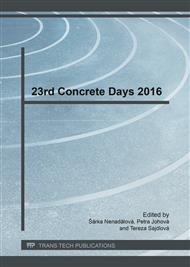p.46
p.52
p.58
p.64
p.70
p.75
p.80
p.85
p.90
Roof Structural System Study with Use of UHPC
Abstract:
This paper deals with the roof structural system using prestressed girders made of ultra-high performance concrete (UHPC). One of the aims of this study is to verify whether the option of the UHPC girders could be under certain boundary conditions competitive with the commonly used construction materials. Due to its high strength, UHPC enables the design of the structural elements with the high load bearing capacity and with smaller slenderness compared to normal strength concrete elements. The price of UHPC is currently still very high compared to the normal strength concretes or steel. Therefore, its use for the usual designed structures does not recently seem too economically attractive. The effect of material savings is nonnegligible in the case, that a self-weight of the structure forms dominant component of the total load. In addition to the high strength, UHPC has very high resistance to environmental influences. It is therefore likely, that UHPC could be advantageously applied e.g. for the roofing of industrial buildings of chemical plants with high aggressive environments, because there are high demands on the life cycle of the structure.
Info:
Periodical:
Pages:
70-74
Citation:
Online since:
May 2017
Authors:
Price:
Сopyright:
© 2017 Trans Tech Publications Ltd. All Rights Reserved
Share:
Citation:


